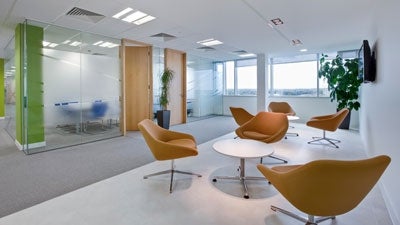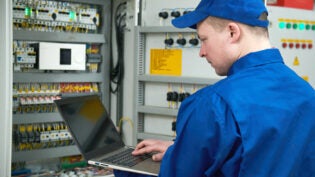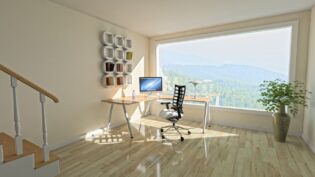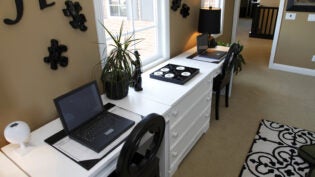
Our company has been recognized as having one of the “Coolest Offices” in Chicago on a number of occasions—most recently by Crain’s Chicago Business.
We’re proud of the accolades because we worked hard to earn them. Years ago, we decided to make our workspace an innovation project, and with the help of San Francisco-based architect Ian Glidden—who moved to Chicago for six months—we made the dreams of our team come to life. Since many companies are now building idea labs and we’re in the innovation consulting business, we’re often asked for tips and tours to talk about what works and what doesn’t when it comes to creating a workspace that spurs new ideas.
So here, with humility, are some of the lessons we’ve learned along the way.
Lesson 1: Distractions Suck (Energy, Focus And Resources)
The steady increase in information is leading to a deficit in attention. And attention is becoming the most valuable currency in business. So why would you create a space that creates more distractions for your team? Distractions suck time, energy and dollars.
Open floor plans are at the center of this sucking sound. While they are often celebrated for their ability to create collaboration, they also create more distractions than they are worth. It is hard to be creative when you can hear what the person next to you is ordering for lunch.
If you are going to have an open plan, you must also have plenty of private spaces that your folks can use without penalty. The open spaces must be used for specific collaborative activities.
At the insistence of a team member, we recently retried the open concept in a small part of our office, which we titled “The Collaboratorium.” It immediately became a stage for the primary proponent of the idea. He lectured, munched crunchy foods and bedazzled anyone who would give him attention. All that was missing was a spotlight. Headphones became necessary for everyone within earshot. He no longer works at our company, nor do the two people who sat closest to him. Coincidence? Probably not.
To be fair, I suspect I would have done the same thing if I were he, being the extraverted distraction that I am. Understandable or not, open plans are a bad idea.
Related Article: 4 Ways to Map Your Office Design to Your Company Culture
Still, I’m happy we experimented with open floor plans. The desire and ability for our company to embrace experimentation remains our highest priority, and we actually relearned some valuable lessons along the way.
Here’s the biggest one:
Start by giving your folks a primary space that is private and allows them to focus. Then, and only then, create lots of cool open areas where the team can easily gather and collaborate. In other words, friends don’t let friends create completely open environments.
Lesson 2: Write On Walls
As kids, our parents taught us not to write on walls. As adults, the opposite is true—at least if you want ideas to flow. Surfaces that allow people to stop, doodle, post and build are critical for idea building. Those surfaces include whiteboards, corkboards, Bluetooth-synced TV monitors, etc., which make it easy to have a brainstorm everywhere and anywhere in the office. You want people to be able to communicate with pens, Post-it notes or pixels.
Lesson 3: Luminosity And Coffee Are Completely Subjective
We’ve experimented with how bright rooms should be and which blend of coffee to serve. The conclusion: different strokes for different folks. There are as many people who like to be vampires as those who want bright sunshine. Really. When we built our space, I got so frustrated with the mixed feedback that I quantified it, and the split was almost exactly 50/50. In the end, we all got so tired of turning the lights on and off that we just disabled two-thirds of our bulbs and called it a draw.
As far as coffee goes, the day after you switch to the brand that dominated the previous companywide taste test, people will be demanding a recount. Coffee is a partisan issue.
Light and coffee choice are the great office enigmas. Embrace the riddle and move on.
Lesson 4: Bees Go To Honey
If you want to force cross-pollination of ideas, one of the best ways we’ve found to do this is to place your “flowers” in the corners of the office. Flower is a metaphor for people whose personalities or job descriptions cause frequent visits by all kinds of teammates in the office. On the walk over to see them, your folks will run into others who can also help spur their creativity.
We all know this is how the best ideas often happen.
Lesson 5: Your Office Is A Canvas
When we finished our office, I remember being concerned about how sterile it seemed. There were just too many blank walls and surfaces. Ian, the architect, suggested that I be patient and allow the people in the firm to make the office their own. Proving he was right, we now have Elvis and Barbie on the bathroom doors, enough musical instruments and amps in the lobby to accommodate a large rock band, and a fully functioning Segway leaning against a wall,. Touché, Ian, touché.
The lesson is pretty simple: Let your people make the space their own. There is no better way to make sure your space embodies your culture.
Author’s note: But be prepared for some unnerving demonstrations of creative genius. My favorite being the mock exorcism—complete with rubber chicken, strobe light and chanting monks—that was used to “cleanse” an office that had been somewhat of a revolving door for employees. It was a bit unsettling for “Geri” on her first day of work.
Lesson 6: Introverts And Extroverts Are Awesome!
On the Myers-Briggs Type Indicator scale, I’s (this stands for introverts — people who focus on inner ideas, impressions and feelings) and E’s (extroverts — the folks who are constantly looking outside themselves and interacting with others) are distinguished by where they get their energy. When it comes to ideas, high I’s need to contemplate in peace, and high E’s want a brainstorm with everyone in the building. Office design needs to be able to accommodate both, or you will exhaust your best people.
When you design your space, take care to have both social and private settings available for everyone. Make it easy for people to find and use both. Oh, and this goes for your clients, too.
If you do, innovative ideas will flourish.
This article was originally published by Free the Idea Monkey
Published: May 4, 2015
2911 Views
2911 Views












